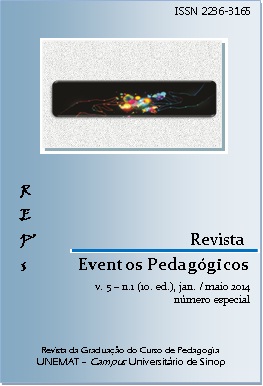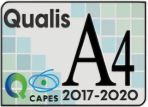Visual literacy: the interpretation of images in English classes
DOI:
https://doi.org/10.30681/reps.v5i1.9496Resumo
My goals in this article are to discuss the area of visual literacy and summarize the talk presented at the XVI Convention of English Teachers realized by APLIEMT - The Association of English Teachers of Mato Grosso, in 2013. In the first part of the article, I investigate three key concepts that influence the education of foreign/additional secondary languages: globalization, the roles of English and new technologies. In the second part, I discuss the area of visual literacy. Finally, I refer to some activities as examples of visual literacy.
Keywords: globalization; visual literacy; English language education.
Downloads
Referências
ANDERSEN, B. Imagined Communities: Reflection on the Origin and Spread of Nationalism. London e New York: Verso (edição revisada), 2006.
APPADURAI, A. Grassroots globalization and the research imagination. In: Public Culture, 12 (1), p. 1-19. Minneapolis, MN: University of Minnesota Press, 2000.
______ . The Right to Research. In: Globalization, Societies, and Education. 4.2, p. 167-77, 2006.
APPADURAI, A. Modernity at Large: Cultural Dimensions of Globalization. Minnesota & London: Minnesota University Press, 8 ed., 2008.
BRYDON, D. Building Global Democracy. Programme Prospectus (2008-2012), 2008. Disponível em: . Acesso em: 20 dez. 2013.
______ . Reclaiming the Local in Language Policy and Practice. New Jersey: Lawrence Erlbaum Associates, 2005.
______ . Why Community Matters. In: BRYDON, D.; Coleman W.D. (eds). Renegotiating Community: interdisciplinary perspectives, global contexts. Vancouver: UBC Press, 2008.
______ . Globalization and Higher education: working toward cognitive justice. In: Center for Globalization and Cultural Studies. University of Manitoba, Canada. 2009.
BUCK-MORSS, S. Visual Studies and Global Imagination. In Papers of Surrealism, issue2, 2004.
CANAGARAJAH, A. S. Resisting linguistic imperialism in English teaching. Oxford: Oxford University Press, 1999.
DUBOC, A. P. M.; FERRAZ, D. M. Letramentos Críticos de professores de inglês: Currículos e perspectivas em expansão. Revista X, v.1, p. 19 - 32, 2011.
DUSSEL, I. Education and the Production of Global Imaginaries: A Reflection on Teachers’ Visual Culture. In: Yearbook of the National Society for the Study of Education, 2009.
FERRAZ, D. M. Reflections on Visual Literacy as learning spaces for theories and practices. Crop (FFLCH/USP), v. 13, p. 162-173, 2008. Disponível em: <http://www.fflch.usp.br/dlm/crop/edicaoatual.htm >. Acesso em: 23 mar. 2010.
______ . EELT. Education through English Language Teaching and Visual Literacy: an interweaving perspective. Contexturas, v. 17, p. 39 – 56, 2010b.
______ . Os Novos Letramentos e o Ensino de Língua Inglesa: expandindo perspectivas em contextos de educação superior de tecnologia. Revista V@rVitu, 2012.
GARCIA-CANCLINI, N. La Globalización Imaginada. Buenos Aires: Paidós, 2005.
KALANTZIS, M.; COPE, B, M. Multiliteracies: literacy learning and the design of social futures. London: Routledge, 2000.
GRUPO ESCOLAR. Origem do Homem. Disponível em: <http://www.grupoescolar.com/pesquisa/origens-do-homem.html>. Acesso em: 30 dez. 2013.
KALANTZIS, M.; COPE, B, M. New Learning. Elements of a Science of Education. Melbourne: Cambridge, 2008.
______ . New Media, New Learning. In: COLE, D.; PULLEN, D (eds.). Multiliteracies in Motion: Current theory and practice. New York and London: Routledge, 2010.
KRESS, G.; van LEEUWEN, T. Reading images: the grammar of visual design. London and New York: Routledge, 2006.
KUMARADIVELU, B. Individual identity, cultural globalization and teaching English as an international language: The case for an epistemic break. In ALSAGOFF, L., RENANDYA, W.; HU, Guangwei; MCKAY, S. (eds.).Teaching English as an International Language: Principles and Practices (pp. 9-27). New York: Routledge, 2012.
LANKSHEAR, C.; KNOBEL, M. New Literacies: Changing Knowledge and Classroom Research. Buckingham: Open University Press, 2007a.
______ . A New Literacies Sampler. New York: Peter Lang, 2007b.
______ . Digital Literacies: Concepts, Policies, and practices. New York: Peter Lang, 2008.
MENEZES DE SOUZA, L.M. Post-Colonial Literature and a Pedagogy of Re-Visioning: the contribution of Wilson Harris. In: Claritas. São Paulo, 1994.
______ . Global Learning in the Knowledge Society: four tools for discussion. In: Zeitschrift für internationale Bildungsforschung und Entwicklungspädagogik, v. 31, Nuermberg, Alemanha, 2008.
MIZAN, S. CNN News of September 11th: a Representation of reality or the Reality of Representation. Dissertação de Mestrado. São Paulo: USP, 2004.
PENNYCOOK, A. The Cultural Politics of English as an International Language. Londres. Nova Iorque: Longman, 1994.
______ . English and the Discourses of Colonialism (Politics of Language). London: Routledge, 1998.
______. Global Englishes and Transcultural Flows. Londres: Routledge, 2007a.
______ . The Myth of English as an International Language. In: MAKONI, S.; PENNYCOOK, A. Disinventing and Reconstituting Languages. Clevedon: Multilingual Matters, 2007b.
SANTOS, B. S. Globalizations. Theory, Culture, Society. v. 23, p. 393-399. SAGE Publications, 2006.
WARSCHAUER, M. The changing global economy and the future of English teaching. TESOL Quarterly 34, 511-535, 2000.
Downloads
Publicado
Edição
Seção
Licença
Copyright (c) 2022 Revista Eventos Pedagógicos

Este trabalho está licenciado sob uma licença Creative Commons Attribution 4.0 International License.
O conteúdo deste periódico está licenciado sob CC BY-SA 4.0 (Atribuição-Compartilha-Igual 4.0 Internacional)[1]. Esta licença permite que os reutilizadores distribuam, remixem, adaptem e desenvolvam o conteúdo em qualquer meio ou formato, desde que a atribuição seja dada ao criador e que o conteúdo modificado seja licenciado sob termos idênticos. A licença permite o uso comercial.
[1] Para ver uma cópia desta licença, visite: https://creativecommons.org/licenses/by-sa/4.0/deed.pt_BR.






